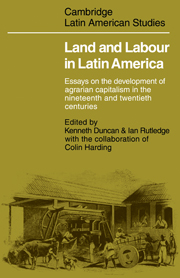 Land and Labourin Latin America
Land and Labourin Latin America Book contents
- Frontmatter
- Contents
- List of tables
- List of figures
- List of maps
- Acknowledgements
- 1 Introduction: patterns of agrarian capitalism in Latin America
- PART I THE TRANSITION FROM TRADITIONAL HACIENDA TO CAPITALIST ESTATE
- PART II THE DEVELOPMENT OF A PLANTATION ECONOMY WITH LABOUR RECRUITMENT FROM HIGHLAND PEASANT COMMUNITIES
- 8 The integration of the highland peasantry into the sugar cane economy of northern Argentina, 1930–43
- 9 The social and economic consequences of modernization in the Peruvian sugar industry, 1870–1930
- 10 The dynamics of Indian peasant society and migration to coastal plantations in central Peru
- 11 A Colombian coffee estate: Santa Bárbara, Cundinamarca, 1870–1912
- PART III THE DEVELOPMENT OF COMMERCIAL AGRICULTURE USING EUROPEAN IMMIGRANT LABOUR
- PART IV THE TRANSITION FROM SLAVE PLANTATION TO CAPITALIST PLANTATION
- PART V POSTSCRIPT
- Glossary of Spanish and Portuguese terms used in the text
- Weights and measures
- Notes on contributors
- Indexes Subjects
- Authors
8 - The integration of the highland peasantry into the sugar cane economy of northern Argentina, 1930–43
Published online by Cambridge University Press: 07 May 2010
- Frontmatter
- Contents
- List of tables
- List of figures
- List of maps
- Acknowledgements
- 1 Introduction: patterns of agrarian capitalism in Latin America
- PART I THE TRANSITION FROM TRADITIONAL HACIENDA TO CAPITALIST ESTATE
- PART II THE DEVELOPMENT OF A PLANTATION ECONOMY WITH LABOUR RECRUITMENT FROM HIGHLAND PEASANT COMMUNITIES
- 8 The integration of the highland peasantry into the sugar cane economy of northern Argentina, 1930–43
- 9 The social and economic consequences of modernization in the Peruvian sugar industry, 1870–1930
- 10 The dynamics of Indian peasant society and migration to coastal plantations in central Peru
- 11 A Colombian coffee estate: Santa Bárbara, Cundinamarca, 1870–1912
- PART III THE DEVELOPMENT OF COMMERCIAL AGRICULTURE USING EUROPEAN IMMIGRANT LABOUR
- PART IV THE TRANSITION FROM SLAVE PLANTATION TO CAPITALIST PLANTATION
- PART V POSTSCRIPT
- Glossary of Spanish and Portuguese terms used in the text
- Weights and measures
- Notes on contributors
- Indexes Subjects
- Authors
Summary
Introduction
Most studies of plantation systems, and especially those dealing with sugar cane economies, have concentrated on cases where the product is sold for export on the international market, and it has become more or less a commonplace to think of ‘plantation economy’ as being synonymous with ‘export economy’. However, in the case of Argentina there developed in the latter part of the nineteenth century a large and economically important plantation system whose product was destined almost entirely for a protected internal market. This sugar cane economy was based largely in the northwestern province of Tucumán, but later expanded further to the north into the provinces of Salta and Jujuy. Protected by high tariff barriers and liberally financed by banking credits, the Argentine sugar industry of the late nineteenth and early twentieth centuries provides one of the first examples of ‘import substitution’ in Latin America. However, despite these apparently modern and economically progressive features, the internal logic of the plantation system inevitably asserted itself in the field of production relations and patterns of labour recruitment, with the result that, for a certain period, a modern and technologically advanced agro-industry operated labour policies which were manifestly backward and coercive. In Tucuman these features were somewhat mitigated by factors which cannot be dealt with in this paper, but in the provinces of Salta and Jujuy archaic forms of production relations predominated until as late as the early 1940s.
- Type
- Chapter
- Information
- Land and Labourin Latin AmericaEssays on the Development of Agrarian Capitalism in the nineteenth and twentieth centuries, pp. 205 - 228Publisher: Cambridge University PressPrint publication year: 1978
- 2
- Cited by


